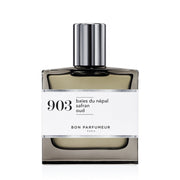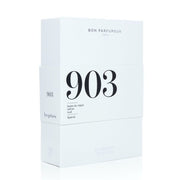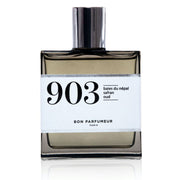903 Nepal Berry, Saffron and Oud Eau de Parfum by Le Bon Parfumeur
- Home
- All
- 903 Nepal Berry, Saffron and Oud Eau de Parfum by Le Bon Parfumeur
903 Nepal Berry, Saffron and Oud Eau de Parfum by Le Bon Parfumeur
Product Description:
Animalistic woods, eroticism and mystery. The fragrance opens on an intriguing contrast between the fresh notes of Nepalese pepper, also known as Timur pepper, and the warm notes of saffron. It then reveals a sophisticated accord of Tonkin musk and cashmeran. Next it creates a striking sensation, an erotic impression of bodies seeking out and finding one another before melding beautifully together in a spellbinding symbiosis. Pervaded by oud and sandalwood, a woody base enhances this vibrant note. PS: Serge de Oliveira is renowned for his gift for working animalistic notes.
What does Nepalese pepper smell like?
Nepalese pepper is also known as Timut pepper. This pepper is all the rage in cooking and belongs to the same family as Sichuan pepper. It has an extraordinary fragrance of citrus fruits and grapefruit. You can also detect a lemony floral hint with a base of exotic fruits. This spice can be found all across Nepal, primarily in the Terai region of wetlands in the south of the country, where it is eaten on a daily basis. The Terai is the birthplace of the Buddha. Timur pepper is harvested over an average period of three weeks. The thorns on the Timur bush make the task long and difficult. Its berries are dried in the sun and the aromatic black seed emerges from its casing.
What is the story behind Tonkin musk?
The favorite fragrance of Empress Josephine and a legendary perfume ingredient, Tonkin musk has an extremely powerful scent that is both woody and animalistic. Produced by the glands of the musk deer, Tonkin musk was considered to be an aphrodisiac and was drunk with a straw. Oh dear! Today it is illegal to obtain musk from the deer, but it is now possible to recreate its scent. Ambrette, for example, is a flower with a musky smell.
What is oud?
Oud, oodh, agarwood, aloeswood, calambac, jinko or gaharu – there are so many names for this one ingredient! It is a very fragrant dark resin produced by a genus of trees called Aquilaria when they are infected with the Phialophra mold. Once the tree has produced an abundance of the black resin, it is cut into chips and then soaked in water to prepare it for extraction. If it isn’t soaked for long enough, the oil will tend to stay inside. However if it is soaked for too long, it can spoil the scent. It is therefore a matter of precision timing! Finally, the wood obtained must be distilled for many hours using distillation apparatus to obtain the essential oil. That is why it is one of the most expensive ingredients in perfumery and it is said that the wood is worth more than its weight in gold. This precious wood reveals woody, animalistic, sometimes even very animalistic notes. It is occasionally said that it has caprine notes (i.e. reminiscent of goats). It is truly an olfactory treasure for fragrance compositions that combine sensuality and power.
Mix & Match:
Become your very own perfumer by mixing two fragrances together. Strike the right balance for a result that is just as unique as you are. 101 lends this intense oud soft and floral facets with a hint of rose. When paired with 302, 903 becomes even muskier and more sensual.
Produced by Ludovic Bonneton, former digital director of Yves Rocher, Le Bon Parfumeur is a Paris-based company producing perfumes containing three basic scents. Designed to be mix-and-match, the collection is coordinated by color label with the first digit of the scent signifying scent family.
The Le Bon Parfumeur Collection is available here.





